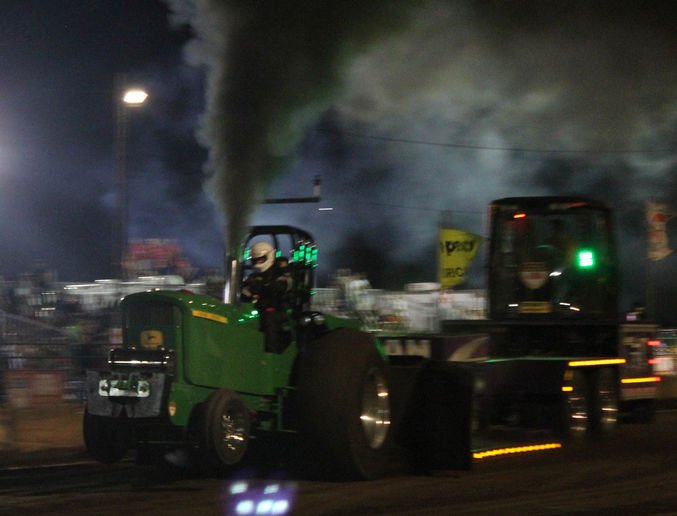You should upgrade or use an alternative browser.
- Thread starter JDBRIDER
- Start date
Geo-TH,In
Well-known Member
I never used water injection.
I think, can't really remember so this might be wrong, I think my brother's 1936 JD D might have used some water from radiator. Tractor may have been able to burn gas or diesel. Perhaps some old timers can correct me. I was only a kid when he had it.
May want to ask the boys on JD forum.
geo.
Texasmark1
Well-known Member
Water has two functions, it keeps the temp down and slows combustion to avoid engine damage. That allows more fuel to be burned. Also when it turns to steam its' volume increases 1600 times! Adds pressure to the piston or turbine.
Back in the early 60s GM made a cool little aluminum v8 in the Buick special and Olds f85. The Olds version had a turbocharger and very high compression, normally a no-no, but they used water injection to make it work. That was way before computerized engine management with timing control and knock sensors. Worked, if you kept the reservoir full!!
37chief
Well-known Member
- Location
- California
rustyfarmall
Well-known Member
I believe that Massey-Harris also used water injection at one time. Possibly on the 55?
Water injection was used on many internal combustion engines. It was NOT just aircraft or military applications.
The water turns to steam in the combustion chamber. Steam has anti-knock properties, aids in cooling, and yes, it does increase power. Steam will also CLEAN the combustion chamber.
notjustair
Well-known Member
big tee
Well-known Member

Pete in Holland MI
Member
My Rumely M has nearly equal sized water & kerosene tanks. Understand at full load, water & kerosene were about 50-50.
buickanddeere
Well-known Member
Water Injection does not make more power. Water injection allows more power to be made WITHOUT excessively high temps on the compression stroke on the D and such. And water iniection prevents excessively high egt with turbo diesels and gas turbines.
All the water does is absorb heat which lowers the temperature of the gasses. Water does not burn. The steam from water injection does clean the soot and carbon out which can improve performance.
Tramway Guy
Well-known Member
Geo-TH,In
Well-known Member
I thought the JD D did use water. Thanks for confirming my old term memory is still working.
Vet told me water injection was also used for a burst of power to get away form enemy in a dog fight. He claimed it could only be used a short time because it cooled the engine temp too much.
Again, this is testing my old term memory.
geo
Also saw a film clip on the Military Channel of a F4U Corsair taking off from a carrier using a 'rocket assisted takeoff' bottle for added thrust. It looked like it was under the fuselage.
Garry
coonie minnie
Well-known Member
jimg.allentown
Well-known Member
One peculiar thing about the turbo engines - the distributor did not use a vacuum advance. It had a similar looking device that retarded the timing while under boost to reduce detonation. One of GM's better designs.
buickanddeere
Well-known Member
(quoted from post at 22:09:10 06/20/17) I have always heard that some WWII fighters, P-51 or P-47, had a 'gate' at the top of the throttle quadrant, protected by breakaway safety wire. Up to the safety wire was 'military power', past the wire was 'war emergency power', which was an intentional overboost of the engine that gave more power for a short duration, if needed in a combat situation.
Also saw a film clip on the Military Channel of a F4U Corsair taking off from a carrier using a 'rocket assisted takeoff' bottle for added thrust. It looked like it was under the fuselage.
Garry
When in emergency over boost power , the water injection was also placed in service. the amount of water on board was limited thus emergency over boost duration was limited.
Texasmark1
Well-known Member
Similar threads
- Replies
- 2
- Views
- 283
We sell tractor parts! We have the parts you need to repair your tractor - the right parts. Our low prices and years of research make us your best choice when you need parts. Shop Online Today.
Copyright © 1997-2024 Yesterday's Tractor Co.
All Rights Reserved. Reproduction of any part of this website, including design and content, without written permission is strictly prohibited. Trade Marks and Trade Names contained and used in this Website are those of others, and are used in this Website in a descriptive sense to refer to the products of others. Use of this Web site constitutes acceptance of our User Agreement and Privacy Policy TRADEMARK DISCLAIMER: Tradenames and Trademarks referred to within Yesterday's Tractor Co. products and within the Yesterday's Tractor Co. websites are the property of their respective trademark holders. None of these trademark holders are affiliated with Yesterday's Tractor Co., our products, or our website nor are we sponsored by them. John Deere and its logos are the registered trademarks of the John Deere Corporation. Agco, Agco Allis, White, Massey Ferguson and their logos are the registered trademarks of AGCO Corporation. Case, Case-IH, Farmall, International Harvester, New Holland and their logos are registered trademarks of CNH Global N.V.
Yesterday's Tractors - Antique Tractor Headquarters
Website Accessibility Policy

